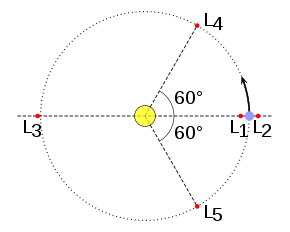
Back Trojaan (sterrekunde) Afrikaans طروادة (علم الفلك) Arabic Trojaner (Astronomie) BAR ترۆجان (تەنی ئاسمانی) CKB Trojaner (Astronomie) German Τρωικό αντικείμενο Greek Trujàṅ EML Troiar (astronomia) Basque تروجان (اخترشناسی) Persian Troyen (astronomie) French

In astronomy, a trojan is a small celestial body (mostly asteroids) that shares the orbit of a larger body, remaining in a stable orbit approximately 60° ahead of or behind the main body near one of its Lagrangian points L4 and L5. Trojans can share the orbits of planets or of large moons.
Trojans are one type of co-orbital object. In this arrangement, a star and a planet orbit about their common barycenter, which is close to the center of the star because it is usually much more massive than the orbiting planet. In turn, a much smaller mass than both the star and the planet, located at one of the Lagrangian points of the star–planet system, is subject to a combined gravitational force that acts through this barycenter. Hence the smallest object orbits around the barycenter with the same orbital period as the planet, and the arrangement can remain stable over time.[1]
In the Solar System, most known trojans share the orbit of Jupiter. They are divided into the Greek camp at L4 (ahead of Jupiter) and the Trojan camp at L5 (trailing Jupiter). More than a million Jupiter trojans larger than one kilometer are thought to exist,[2] of which more than 7,000 are currently catalogued. In other planetary orbits only nine Mars trojans, 31 Neptune trojans, two Uranus trojans, and two Earth trojans, have been found to date. A temporary Venus trojan is also known. Numerical orbital dynamics stability simulations indicate that Saturn probably does not have any primordial trojans.[3]
The same arrangement can appear when the primary object is a planet and the secondary is one of its moons, whereby much smaller trojan moons can share its orbit. All known trojan moons are part of the Saturn system. Telesto and Calypso are trojans of Tethys, and Helene and Polydeuces of Dione.
- ^ Robutel, Philippe; Souchay, Jean (2010). "An introduction to the dynamics of trojan asteroids". In Dvorak, Rudolf; Souchay, Jean (eds.). Dynamics of Small Solar System Bodies and Exoplanets. Lecture Notes in Physics. Vol. 790. Springer. p. 197. ISBN 978-3-642-04457-1.
- ^ Yoshida, F.; Nakamura, T. (December 2005). "Size Distribution of Faint Jovian L4 Trojan Asteroids". The Astronomical Journal. 130 (6): 2900–2911. Bibcode:2005AJ....130.2900Y. doi:10.1086/497571.
- ^ Sheppard, Scott S.; Trujillo, Chadwick A. (June 2006). "A Thick Cloud of Neptune Trojans and their Colors". Science. 313 (5786): 511–514. Bibcode:2006Sci...313..511S. doi:10.1126/science.1127173. PMID 16778021. S2CID 35721399.